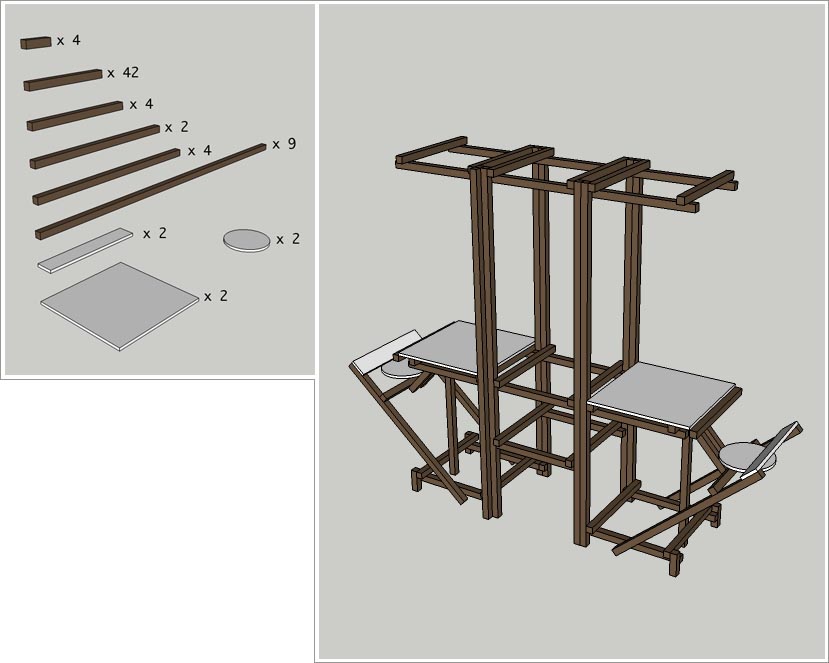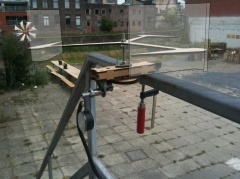Difference between revisions of "Version"
| (38 intermediate revisions by the same user not shown) | |||
| Line 6: | Line 6: | ||
| − | + | ==== ''To Dominique'' ==== | |
---- | ---- | ||
| Line 41: | Line 41: | ||
Taken from a project proposal written to Dominique Leroy, following my residence at [http://www.ecosnantes.org Ecos] in march 2011. | Taken from a project proposal written to Dominique Leroy, following my residence at [http://www.ecosnantes.org Ecos] in march 2011. | ||
| − | + | ==== ''Version'' ==== | |
---- | ---- | ||
The organizations I used to be part of, (OKNO/Code31) always provided me with a framework, facilitating the working process, enabling the ideal conditions for creative work. Since I'm no longer part of a collective, how can I create it by means of my own work. | The organizations I used to be part of, (OKNO/Code31) always provided me with a framework, facilitating the working process, enabling the ideal conditions for creative work. Since I'm no longer part of a collective, how can I create it by means of my own work. | ||
| − | In [http://www.baltanlaboratories.org/?p=2194 the future of the lab] the discussion is on how labs function, what they have in common, | + | In [http://www.baltanlaboratories.org/?p=2194 the future of the lab] the discussion is on how labs function, what they have in common, what the ''prototypical lab'' could look like. A lot of what is discussed also applies to the work or working method of the individual artist. So I wondered, looking at it form the point of an individual artist, what could be a prototypical way of working for me? What does working within these labs or collectives mean for my working process. How to engage? |
| − | |||
| − | |||
| − | |||
| − | |||
| − | |||
| − | |||
| − | |||
| − | |||
| − | |||
Moving your project from one lab to the other, presenting during a exhibition held by organization A, participating or leading workshops for lab B, discussing online on a platform maintained by C. Al these are stages in the development of a project. | Moving your project from one lab to the other, presenting during a exhibition held by organization A, participating or leading workshops for lab B, discussing online on a platform maintained by C. Al these are stages in the development of a project. | ||
| − | |||
| − | |||
| − | |||
| − | |||
'''Version''' builds upon [http://Openstructures.net Openstructures], a project which explores the possibilities of a modular construction model based upon a geometric grid. This model provides a shared framework for tinkering, prototyping and experimenting. It's a collaborative model where everyone contributes with parts, components and structures. | '''Version''' builds upon [http://Openstructures.net Openstructures], a project which explores the possibilities of a modular construction model based upon a geometric grid. This model provides a shared framework for tinkering, prototyping and experimenting. It's a collaborative model where everyone contributes with parts, components and structures. | ||
| Line 72: | Line 59: | ||
'''Version''' starts with the development of "Version:base". A small mobile lab, built according to the principles of the openstructures model. It is a simple empty shape which holds space for two persons. This is the starting point. It will get shaped, altered or expanded. New components will be added. Parts will be removed. It will get transported and installed at different locations. Parts will get abandoned. All according to the development of projects within the version context. | '''Version''' starts with the development of "Version:base". A small mobile lab, built according to the principles of the openstructures model. It is a simple empty shape which holds space for two persons. This is the starting point. It will get shaped, altered or expanded. New components will be added. Parts will be removed. It will get transported and installed at different locations. Parts will get abandoned. All according to the development of projects within the version context. | ||
| − | What shaped my ideas for this approach was my involvement in the [http://okno.be OKNO] project [http://timeinventorskabinet.org/ Time inventors kabinet], and my residency at [http://ecosnantes.org Ecos]. | + | What shaped my ideas for this approach was my involvement in the [http://okno.be OKNO] project [http://timeinventorskabinet.org/ Time inventors kabinet], and my residency at [http://ecosnantes.org Ecos]. Why not really make a kabinet, after all I am involved in this project which is Called Time inventors kabinet. And what's a kabinet other then a lab or a workspace. My workspace would become a kabinet. That was a start. Then I thought to make it mobile, meaning I should be able to displace this lab. It should not be inside my workspace. |
| − | + | Especially not as I'm working with wind. I had to take my lab outside. I had to make it open. Open in the sense of an open lab. Open for people to enter and participate. A kabinet is also a piece of furniture, a shelve, a display. Then I came across http://openstructures.net. | |
| − | Why not really make a kabinet, after all I am involved in this project which is Called Time inventors kabinet. And what's a kabinet other then a lab or a workspace. My workspace would become a kabinet. That was a start. | ||
| − | |||
| − | Then I thought to make it mobile, meaning I should be able to displace this lab. It should not be inside my workspace. | ||
| − | Especially not as I'm working with wind. I had to take my lab outside. | ||
| − | |||
| − | I had to make it open. Open in the sense of an open lab. Open for people to enter and participate. | ||
| − | |||
| − | A kabinet is also a piece of furniture, a shelve, a display. | ||
| − | |||
| − | Then I came across http://openstructures.net. | ||
In there I found the structure, the form which my cabinet should take. Or the way I should proceed in building my Kabinet. | In there I found the structure, the form which my cabinet should take. Or the way I should proceed in building my Kabinet. | ||
| Line 100: | Line 77: | ||
mobile, | mobile, | ||
others can built upon, add, adjust, use, … | others can built upon, add, adjust, use, … | ||
| + | |||
| + | ===== ''About Openstructures''===== | ||
| + | ---- | ||
| + | the openstructures ruler or geometrical grid<br> | ||
| + | [[File:60x60cm.jpg|center|640px]] | ||
| + | |||
| + | ==== ''Projects''==== | ||
| + | ---- | ||
| + | |||
| + | A few examples/projects I'm currently involved with, which I would like to develop according to the openstructures model. | ||
| + | |||
| + | *[[ATKNv2|ATKNv2]] : a second version of the ATKN windmill, this time a speech generating windmill | ||
| + | *[[Version#scenario_for_Ecos|proposal for Ecos, Nantes]] : possible scenario, working and implementing ATKNv2 at Ecos site in Nantes | ||
| + | *[[Version#scenario_for_Ecos|mobile lab]] : starting point is an empty lab, easily implemented at remote sites. | ||
| + | *[[David de Buyser|F-Box]] : collaborating with David De Buyser who engaged himself to work within Version framework on his new project. | ||
| + | *[[daylighting|daylighting]] : an artist's attempt to improve his workspace | ||
===== ''Version:base''===== | ===== ''Version:base''===== | ||
| Line 105: | Line 98: | ||
[[File:Version_base.jpg|center|version:base]] | [[File:Version_base.jpg|center|version:base]] | ||
| − | + | ==== '' scenario for Ecos''==== | |
---- | ---- | ||
"<br> | "<br> | ||
...<br> | ...<br> | ||
| − | I'm still working on new windmills and devices, dealing with the same concepts as the old ATKN project: energy, art, communication, poetics, | + | I'm still working on new windmills and devices, dealing with the same concepts as the old [[ATKN]] project: energy, art, communication, poetics, |
| − | The idea is to start working on the site in Rezé, CENTSIXSEMENCES. | + | The idea is to start working on the site in Rezé, [http://www.ecosnantes.org/?page_id=444 CENTSIXSEMENCES]. |
| − | First thing to do would be to install version:base. It contains space for two people. | + | |
| + | First thing to do would be to install version:base. It contains space for two people. I would very much like to open it up, so people are invited to join me from the very first moment. | ||
I need some elevation to catch the wind, so I thought to start building upon the concrete building, | I need some elevation to catch the wind, so I thought to start building upon the concrete building, | ||
| − | or upon the wall surrounding the site. (I | + | or upon the wall surrounding the site. I thought of building a bigger, traditional style type of windmill. I came across [http://atkn.org/dk/index.php/File:Windmill.jpg a model] in ''1800 Mechanical Movements, Devices and Appliances (Dover Science Books)'' , which I would very much like to built using the openstructures model. See if I use it to drive a bellow with this windmill. cfr. Von Kempelen. |
| − | to | + | |
| + | This would be my first work, seeing how and where to built it on the Rezé site. | ||
| + | |||
Smaller structures could be exported into the city, to other interesting locations. These smaller structures | Smaller structures could be exported into the city, to other interesting locations. These smaller structures | ||
could contain small experiments, tryouts, to gather data and experiment with, …. | could contain small experiments, tryouts, to gather data and experiment with, …. | ||
| + | |||
Parts of the structure, that i use to built the windmill, could be expanded or used for other purposes. | Parts of the structure, that i use to built the windmill, could be expanded or used for other purposes. | ||
| − | For instance a piece could contain a small | + | For instance a piece could contain a small greenhouse, or an extension could be made to fit a barrel to gather rainwater. |
Whatever, … I think there are lots of possibilities, which fit the other concepts you are working on with ecos, | Whatever, … I think there are lots of possibilities, which fit the other concepts you are working on with ecos, | ||
for instance we could design small structures, which could be attached to balconies to grow plants.<br> | for instance we could design small structures, which could be attached to balconies to grow plants.<br> | ||
| Line 184: | Line 181: | ||
|} | |} | ||
| − | + | ==== '' models for [http://timeinventorskabinet.org/ Time Inventors Kabinet]''==== | |
| + | |||
| + | different models of windclocks | ||
[http://timeinventorskabinet.org/ TIK] is a project, an interest into ecology and media art, a collaborative experiment with time … | [http://timeinventorskabinet.org/ TIK] is a project, an interest into ecology and media art, a collaborative experiment with time … | ||
| Line 192: | Line 191: | ||
workshops, art radio sessions, public access digital media archive, public presentations, conferences and exhibitions, a critical publication … 're-inventing ecological time' | workshops, art radio sessions, public access digital media archive, public presentations, conferences and exhibitions, a critical publication … 're-inventing ecological time' | ||
| − | ''leonardo model'' | + | |
| + | ''leonardo model'': http://timeinventorskabinet.org/wiki/doku.php/windclocks/leonardo#leonardo , first design with Marcio and Isjtar inspired by leonardo type of anemometer | ||
{|style="border-collapse: separate; border-spacing: 5; border-width: 1px; border-style: solid; border-color: #000; padding: 0" | {|style="border-collapse: separate; border-spacing: 5; border-width: 1px; border-style: solid; border-color: #000; padding: 0" | ||
|- | |- | ||
| Line 206: | Line 206: | ||
|- | |- | ||
|} | |} | ||
| − | '' | + | |
| + | ''Venturi model'' | ||
{|style="border-collapse: separate; border-spacing: 5; border-width: 1px; border-style: solid; border-color: #000; padding: 0" | {|style="border-collapse: separate; border-spacing: 5; border-width: 1px; border-style: solid; border-color: #000; padding: 0" | ||
|- | |- | ||
| − | |. | + | |[[File:Venturifixed2.png|240px]] |
| − | |. | + | |[[File:Venturi.jpg|240px]] |
|... | |... | ||
|... | |... | ||
|- valign="top" | |- valign="top" | ||
| − | |style="width: 25%;background-color:white;" | | + | |style="width: 25%;background-color:white;" | |
|style="width: 25%;background-color:white;" | | |style="width: 25%;background-color:white;" | | ||
|style="width: 25%;background-color:white;" | | |style="width: 25%;background-color:white;" | | ||
| Line 220: | Line 221: | ||
|- | |- | ||
|} | |} | ||
| + | |||
''Ed Lenz rotating model'' | ''Ed Lenz rotating model'' | ||
No wings on it yet, but you can already see the shape of the wings. Again based upon the Ed Lenz model. This time with 3 wings like the original. | No wings on it yet, but you can already see the shape of the wings. Again based upon the Ed Lenz model. This time with 3 wings like the original. | ||
| Line 226: | Line 228: | ||
[[File:Atknv2_000.JPG| 240px | atknv2 prototype]] [[File:Atknv2_001.jpg| 240px | atknv2 prototype]] [[File:Atknv2_002.jpg| 240px | atknv2 prototype]] [[File:Atknv2_003.jpg| 240px | atknv2 prototype]] | [[File:Atknv2_000.JPG| 240px | atknv2 prototype]] [[File:Atknv2_001.jpg| 240px | atknv2 prototype]] [[File:Atknv2_002.jpg| 240px | atknv2 prototype]] [[File:Atknv2_003.jpg| 240px | atknv2 prototype]] | ||
| − | + | ==== video ==== | |
short assemblage video of version:base | short assemblage video of version:base | ||
<videoflash type="vimeo">28617432|500|331</videoflash> | <videoflash type="vimeo">28617432|500|331</videoflash> | ||
Revision as of 14:27, 12 October 2011
About "Version: prototypical lab" project, proposal, ideas and documentation.
Contents
To Dominique
"
From: lahaag <in#######ag.org>
Subject: Re: research paper
Date: 26 Aug 2011 14:17:58 GMT+02:00
To: dom <domle#######ree.fr>
Hey Dom,
...
I'm still working on new windmills and devices, dealing with the same concepts as the old ATKN project: energy, art, communication, poetics, … Part of this development is happening now for OKNO and the TIK project. Together with others, I'm developing wind clocks, which are to be put anywhere around the world and get connected to generate a new standard of time, the TIK time, wind time. Anyways that's the concept. It's very much related to what I was doing with the ATKN project. That's probably also the reason why they asked me to participate.
One of the issues, that arose again during the TIK project, is how to present this research or development to the public. A lot of it is tinkering and playing around. Ideas get put down on wiki's, are explored in small models during workshops. There's lots of ideas formulated and concepts made. All very experimental. A lot of threads come out of this research, but not all, lead to something. But that doesn't make them less interesting, tough. They are part of the process. But how to make this process interesting for the public. The public being this collective of people who look at your work with different interests : people expecting to see a work of art, participants in a workshop, other artists looking for information, people interested in the technical aspects, …
On the other side there is the artist, me. I want to share my work with my public, and am concerned how to do this. My work being in progress, under development, in the state it currently is. Normally as an artists you don't show all the intermittent stages of the development of your artwork. You show the end result. But what if this processes is what you are really interested in?
At the same time I was thinking about my own position as an artist, what to do with my organization, my space and so on. As I'm no longer involved in a collective, being no longer part of OKNO, and not setting up Code31 meetings, much resolves about my individual art practice. How to get people involved, to participate, to relate my work to, get the necessary feedback, for inspiration and energy, … I mean, I have always functioned within collectives, and collaboration is essential in my work. How to open it up again?
...
“
Taken from a project proposal written to Dominique Leroy, following my residence at Ecos in march 2011.
Version
The organizations I used to be part of, (OKNO/Code31) always provided me with a framework, facilitating the working process, enabling the ideal conditions for creative work. Since I'm no longer part of a collective, how can I create it by means of my own work.
In the future of the lab the discussion is on how labs function, what they have in common, what the prototypical lab could look like. A lot of what is discussed also applies to the work or working method of the individual artist. So I wondered, looking at it form the point of an individual artist, what could be a prototypical way of working for me? What does working within these labs or collectives mean for my working process. How to engage?
Moving your project from one lab to the other, presenting during a exhibition held by organization A, participating or leading workshops for lab B, discussing online on a platform maintained by C. Al these are stages in the development of a project.
Version builds upon Openstructures, a project which explores the possibilities of a modular construction model based upon a geometric grid. This model provides a shared framework for tinkering, prototyping and experimenting. It's a collaborative model where everyone contributes with parts, components and structures. At the same time it can literally be the platform or the space, modular and open, within which all this experimenting can take place.
Version is a reflection on a working method. A process based upon a consensus on a formal approach of "how to make things" in which sharing and experimenting are key elements. The focus is on the creative process rather then on what comes out of it.
Version refers to 'version control' , a system used to manage changes to documents, programs, and other information stored as computer files. It is most commonly used in software development, where a team of people work on the same files.
Version starts with the development of "Version:base". A small mobile lab, built according to the principles of the openstructures model. It is a simple empty shape which holds space for two persons. This is the starting point. It will get shaped, altered or expanded. New components will be added. Parts will be removed. It will get transported and installed at different locations. Parts will get abandoned. All according to the development of projects within the version context.
What shaped my ideas for this approach was my involvement in the OKNO project Time inventors kabinet, and my residency at Ecos. Why not really make a kabinet, after all I am involved in this project which is Called Time inventors kabinet. And what's a kabinet other then a lab or a workspace. My workspace would become a kabinet. That was a start. Then I thought to make it mobile, meaning I should be able to displace this lab. It should not be inside my workspace. Especially not as I'm working with wind. I had to take my lab outside. I had to make it open. Open in the sense of an open lab. Open for people to enter and participate. A kabinet is also a piece of furniture, a shelve, a display. Then I came across http://openstructures.net.
In there I found the structure, the form which my cabinet should take. Or the way I should proceed in building my Kabinet. I can built my projects using this modular construction model and at the same time built structures within which to show my work. In this sense the work would be the workspace. The workspace would reflect the method. Within this structures I can built my experiments, explore my ideas. The structure can expand and grow according to development. At the same I can invite others to participate to work within the structure.
It's open versatile modifiable adjustable expandable light mobile, others can built upon, add, adjust, use, …
About Openstructures
the openstructures ruler or geometrical grid
Projects
A few examples/projects I'm currently involved with, which I would like to develop according to the openstructures model.
- ATKNv2 : a second version of the ATKN windmill, this time a speech generating windmill
- proposal for Ecos, Nantes : possible scenario, working and implementing ATKNv2 at Ecos site in Nantes
- mobile lab : starting point is an empty lab, easily implemented at remote sites.
- F-Box : collaborating with David De Buyser who engaged himself to work within Version framework on his new project.
- daylighting : an artist's attempt to improve his workspace
Version:base
scenario for Ecos
"
...
I'm still working on new windmills and devices, dealing with the same concepts as the old ATKN project: energy, art, communication, poetics,
The idea is to start working on the site in Rezé, CENTSIXSEMENCES.
First thing to do would be to install version:base. It contains space for two people. I would very much like to open it up, so people are invited to join me from the very first moment.
I need some elevation to catch the wind, so I thought to start building upon the concrete building, or upon the wall surrounding the site. I thought of building a bigger, traditional style type of windmill. I came across a model in 1800 Mechanical Movements, Devices and Appliances (Dover Science Books) , which I would very much like to built using the openstructures model. See if I use it to drive a bellow with this windmill. cfr. Von Kempelen.
This would be my first work, seeing how and where to built it on the Rezé site.
Smaller structures could be exported into the city, to other interesting locations. These smaller structures could contain small experiments, tryouts, to gather data and experiment with, ….
Parts of the structure, that i use to built the windmill, could be expanded or used for other purposes.
For instance a piece could contain a small greenhouse, or an extension could be made to fit a barrel to gather rainwater.
Whatever, … I think there are lots of possibilities, which fit the other concepts you are working on with ecos,
for instance we could design small structures, which could be attached to balconies to grow plants.
...
"
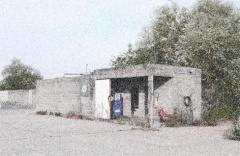
|
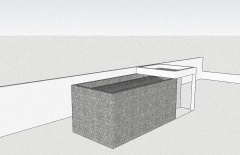
|
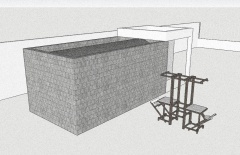
|

|
| 00 : Current situation at Réze site | 01 : First step --> installing Version:base | 02 : Building platform on top op the existing structure for windmill project ATKNv2. | |
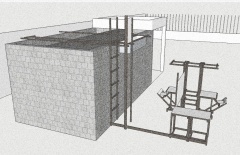
|

|

|

|
| 03 : extending base | 04 : Installing a new type of windmill. | Trunk 00 : adding module for moss_experiment by [David De Buyser ] | 05 : container for storing air compressed by windmill ATKNv2 |
| ... | 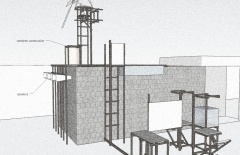
|

|
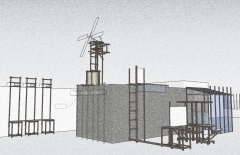
|
| Trunk 00a : adding platform for growing moss | 06 : adding sound chambers for sound. | 07 : moving sound chambers onto wall surrounding ecos site | Trunk 02 : Adding greenhouse for urban gardening project |
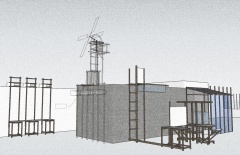
|
... | 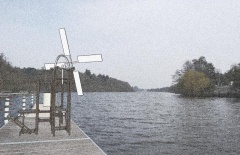
|
... |
| 09 : removing windmill | Trunk 01 : building windmill on remote site 01 | ||
| ... | 
|
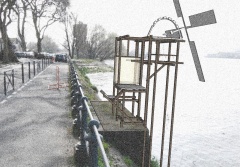
|
... |
| Trunk 02 : building windmill on remote site 02 | Trunk 03 : building windmill on remote site 03 |
models for Time Inventors Kabinet
different models of windclocks
TIK is a project, an interest into ecology and media art, a collaborative experiment with time … taking an ecological approach to observing patterns in time and time control systems… the creative tools we build to generate new audio and visual artworks and mediate a creative discourse on ecological time … an 'horloge a vent'(wind clock), an imaginary time keeping device regulated by the irregular movement of the wind … workshops, art radio sessions, public access digital media archive, public presentations, conferences and exhibitions, a critical publication … 're-inventing ecological time'
leonardo model: http://timeinventorskabinet.org/wiki/doku.php/windclocks/leonardo#leonardo , first design with Marcio and Isjtar inspired by leonardo type of anemometer
| ... | 240px | ... | ... |
Venturi model
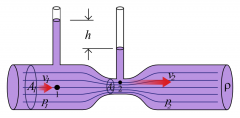
|
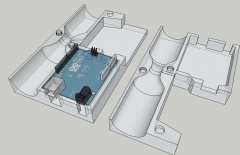
|
... | ... |
Ed Lenz rotating model No wings on it yet, but you can already see the shape of the wings. Again based upon the Ed Lenz model. This time with 3 wings like the original. Idea is to have it drive a air pump (used to inflated car tires. The electronics of the pump are removed. Only the piston I kept, this will be driven by the windmill.
video
short assemblage video of version:base
